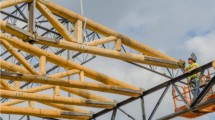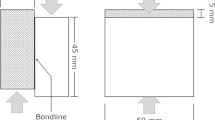Abstract
Ongoing development of timber and timber products made from European hardwoods like ash and beech influences the selection of acceptable methods for connecting these elements and thus demands validation and application of current design methods for softwood and glulam. For the last 20 years, despite many national and international research projects and practical applications of glued-in rods in timber structures, there is still no universal standard with respect to their design. The use of adhesives available for bonding rods and timber is limited to softwood. This work shows the performance of different timber species Norway spruce (Picea abies Karst.), European ash (Fraxinus excelsior L.) and European beech (Fagus silvatica L.) and engineered timber products (laminated veneer lumber made of Norway spruce and European beech) based on comprehensive pull-compression tests of glued-in rods. For characterizing the elastic and elastic-plastic behavior, failure loads as well as stiffness and ductility were considered whereby the rod diameter and anchorage length were maintained constant. The aim of the research was to show that glued-in rods cannot only be used in softwoods and glulam members but also in hardwoods and in wood-based products such as LVL.











Similar content being viewed by others
References
Bainbridge RJ, Mettem CJ, Harvey K, Ansell MP (2000) Fatigue performance of bonded-in rods in glulam, using three adhesive types. Paper 33-7-12. In: Proceedings of 33rd meeting of CIB-W18, Delft, The Netherlands
Blaß HJ, Enders-Comberg M (2012) Truss girders for industrial timber constructions. Vol. 22, Karlsruher reports for timber engineering, KIT Scientific Publishing (in German)
Blaß HJ, Frese M (2010) Damage analysis of timber hall constructions. Vol. 16, Karlsruher reports for timber engineering, KIT Scientific Publishing (in German)
Blaß HJ, Laskewitz B. (1999) Effect of spacing and edge distance on the axial strength of glued-in rods. Paper 32-7-12. In: Proceedings of 32nd meeting of CIB-W18, Graz, Austria
Broughton JG, Hutchinson AR (2001a) Adhesive systems for structural connections in timber. Int J Adhes Adhes 21(1):177–186
Broughton JG, Hutchinson AR (2001b) Pull-out behaviour of steel rods bonded into timber. Mater Struct 34(1):100–109
Del Senno M, Piazza M, Tomasi R (2004) Axial glued-in steel timber joints-experimental and numerical analysis. Holz Roh Werkst 62(2):137–146
DIN 1052:2008 Design of timber structures—general rules and rules for buildings. German Institute for Standardization, Berlin (in German)
EN 12512:2001 Timber structures—Test methods—Cyclic testing of joints made with mechanical fasteners. DIN German Institute for Standardization, Berlin
EN 1382:1999 Timber structures—test methods—withdrawal capacity of timber fasteners. German Institute for Standardization, Berlin
EN 14358:2013 Structural timber—Calculation of characteristic 5-percentile value and mean values for the purpose of initial type testing and factory production control. DIN German Institute for Standardization, Berlin
EN 26891:1991 Timber structures—Joints made with mechanical fasteners—General principles for the determination of strength and deformation characteristics. DIN German Institute for Standardization, Berlin
Feligioni L, Lavisci P, Duchanois G, De Ciechi M, Spinelli P (2003) Influence of glue rheology and joints thickness on the strength of bonded-in rods. Holz Roh Werkst 61(3):281–287
GIROD (2002) Glued in rods for timber structures, SP Rapport 2002:26. Building Technology, Borås
General approval Z-9.1-100: Laminated veneer lumber “Kerto S” and “Kerto Q”, DIBT, Berlin (in German)
General approval Z-9.1-679: Glulam of European beech and hybrid-glulam of European beech, DIBT, Berlin (in German)
General approval Z-9.1-705: 2 K-EP-adhesive WEVO-special resin EP 32 S with WEVO-hardener B 22 TS for gluing steel rods in wood products, DIBT, Berlin (in German)
General approval Z-9.1-707: 2 K-PUR-adhesive PURBOND® CR 421 for gluing steel rods in wood products, DIBT, Berlin (in German)
General approval Z-9.1-838: Laminated veneer lumber of European beech for producing bar-shaped and plane bearing structures “Buchen-FSH längslagig”, “Buchen-FSH querlagig”, DIBT, Berlin (in German)
Harvey K, Ansell MP (2000) Improved timber connections using bonded-in GFRP rods. In: Proceedings of the 6th WCTE, Whistler Resort, British Columbia, Canada
Kangas J, Kevarinmaki A (2001) Quality control of connections based on V-shaped glued-in steel rods. Paper 34-7-4. In: Proceedings of 34th meeting of CIB-W18, Venice, Italy
Knorz M, van de Kuilen JW (2012) Development of a high-capacity engineered wood product—LVL made of European beech (Fagus sylvatica L.). In: Proceedings of the 12th WCTE, Auckland, New Zealand
Otero Chans D, Cimadevila JE, Gutierrez EM (2008) Glued joints in hardwood timber. Int J Adhes Adhes 28(8):457–463
Pörtner C (2005) Studies on bonding between fiber-reinforced rods glued in timber, vol 2. Dissertation, Fachgebiet für Bauwerkserhaltung und Holzbau, Universität Kassel (in German)
prEN 1995-2:2003 Design of timber structures—Part 2: Bridges, CEN European Committee for Standardization
Rajčić V, Bjelanović A, Rak M (2006) Comparison of the pull-out strength of steel bars glued in glulam elements obtained experimentally and numerically. Paper 39-18-1. In: Proceedings of 39th meeting of CIB-W18, Florence, Italy
Riberholt H (1988) Glued bolts in glulam—proposals for CIB code. Paper 21-7-2. In: Proceedings of the 21st meeting of CIB-W18, Parksville, Canada
Richter K, Steiger R (2005) Thermal stability of wood-wood and wood-FRP bonding with polyurethane and epoxy adhesives. Adv Eng Mater 7(5):419–426
Rossignon A, Espion B (2008) Experimental assessment of the pull-out strength of single rods bonded in glulam parallel to the grain. Holz Roh Werkst 66(6):419–432
Serrano E (2001) Glued-in rods for timber structures—a 3D model and finite element parameter studies. Int J Adhes Adhes 21(2):115–127
Steiger R, Gehri E, Widmann R (2004) Glued-in steel rods: a design approach for axially loaded single rods set parallel to the grain, Paper 37-7-8. In: Proceedings of 37th meeting of CIB-W18, Edinburgh, Scotland
Steiger R, Gehri E, Widmann R (2006) Pull-out strength of axially loaded steel rods bonded in glulam parallel to the grain. Mater Struct 40:69–78
Stepinac M, Hunger F, Tomasi R, Serrano E, Rajčić V, van de Kuilen J-W (2013) Comparison of design rules for glued-in rods and design rule proposal for implementation in European standards, Paper 46-7-10. In: Proceedings of 46th meeting of CIB-W18, Vancouver, Canada
Tlustochowicz G, Serrano E, Steiger R (2011) State-of-the-art review on timber connections with glued-in steel rods. Mater Struct 44(11):997–1020
Widmann R, Steiger R, Gehri E (2007) Pull-out strength of axially loaded steel rods bonded in glulam perpendicular to the grain. Mater Struct 40:827–838
Acknowledgments
The work described in this report was conducted at Holzforschung München and financed partially by industry and COST framework. The authors wish to thank the Henkel and Lübbert Warenhandel GmbH for providing adhesives and Gebr. Schütt KG, MetsäWood and Pollmeier Massivholz GmbH & Co. KG for providing the test specimens. We would also like to acknowledge representatives of COST office for their Short Term Scientific Mission grant for Mislav Stepinac who spent 2 months in Munich doing researches on this topic.
Author information
Authors and Affiliations
Corresponding author
Rights and permissions
About this article
Cite this article
Hunger, F., Stepinac, M., Rajčić, V. et al. Pull-compression tests on glued-in metric thread rods parallel to grain in glulam and laminated veneer lumber of different timber species. Eur. J. Wood Prod. 74, 379–391 (2016). https://doi.org/10.1007/s00107-015-1001-2
Received:
Published:
Issue Date:
DOI: https://doi.org/10.1007/s00107-015-1001-2




